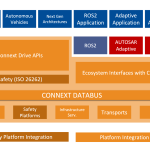Real-Time Innovations (RTI), the Sunnyvale, CA-based software framework company for autonomous systems, today announced at its RTI Automotive Forum that foundational components of Connext Drive are now certified to ISO 26262 ASIL D—the most stringent Automotive Safety Integrity Level for road vehicles.
Connext Drive is already in-use as the underlying software framework for multiple production vehicles on the road, leading to more than 64% compound annual revenue growth (CAGR) for the company over the last three years. According to RTI, it is used by five of the top ten public EV companies (by market cap), including three of the top five.
More broadly, RTI Connext is a leading architecture for developing intelligent distributed systems, sharing data directly, and connecting AI algorithms to real-time networks of devices to build autonomous systems. With over 1700 designs, RTI says its software runs over 250 autonomous vehicle programs, controls the largest powerplants in North America, coordinates combat management on U.S. Navy ships, drives a new generation of medical robotics, enables flying cars, and provides 24/7 intelligence for hospital and emergency medicine.
ASIL-D certification provides OEMs with more assurance of Connext Drive’s suitability for safety-critical applications, including autonomous driving and advanced driver assistance systems (ADAS). RTI will be exhibiting Connext Drive at CES 2022 in Las Vegas in January.
“The release of safety certification in Connext Drive further validates the commitment from RTI to help overcome the architectural limitations currently facing the automotive industry, and ultimately impeding the transition to next-generation vehicles,” said Pedro Lopez Estepa, Market Development Director, Automotive at RTI. “Together with our partner ecosystem, we are leading the automotive software-defined architecture. The new ASIL-D safety solution is another pivotal advancement in our successful automotive journey.”
Software-defined capabilities are a fundamental differentiator in autonomous and electric vehicles. To remain competitive, OEMs must continually innovate, and software development agility is essential, according to RTI. However, it can be stymied by automotive software’s expanding volume and complexity. The need for safety assurance further compounds this challenge.
Connext Drive is intended to accelerate innovation by allowing OEMs to evolve their autonomy applications quickly and cost-effectively. Unlike legacy electrical/electronic (E/E) architectural approaches designed for static vehicle software, Connext Drive employs an agile data-centric integration concept.
It allows systems architects to decompose software into fine-grained and loosely coupled “microservices,” which only need knowledge of the types of data they exchange and not of the implementation or even the presence of any other service. So, developers can add and update services to introduce new capabilities without having to modify or recertify any other software components.
Connext Drive, which RTI says is the first data-centric software framework certified to ASIL D, is part of an automotive ecosystem that is also compliant with the Object Management Group’s DDS (Data Distribution Service) standard. It is integrated with the majority of automotive operating systems, technologies, and platforms—including AUTOSAR and Open Robotics’ ROS (Robot Operating System) 2—providing architects and system engineers with maximum flexibility in developing their full-stack solution.
With today’s announcement, Connext Drive now supports Blackberry’s QNX OS for Safety to ISO 26262 ASIL D, the industry-leading safe real-time operating system offering a reliable and low-risk path to safe, production-grade vehicles.
“Safety, security, and reliability are essential in the design of automotive systems,” said Grant Courville, VP, Products and Strategy at BlackBerry QNX. “With this achievement, RTI joins BlackBerry QNX in offering products certified to the highest level of ISO 26262. Automotive customers can now leverage solutions like the safety-certified Connext Drive and QNX OS for Safety to reduce risk and simplify their overall system certification requirements.”
Connext Drive’s libraries and APIs (application programming interfaces) allow developers to write loosely coupled software modules that communicate seamlessly regardless of whether they are running in the same or different electronic control units, in-vehicle or off-vehicle, or are written in different programming languages. It provides the high-throughput needed to distribute LiDAR and camera data together with the low latency and real-time quality of service necessary for time-critical processing.
- RTI Connext Drive architecture.
- RTI Connext Drive future-proof concept.
- RTI Connext Drive components.


















































































